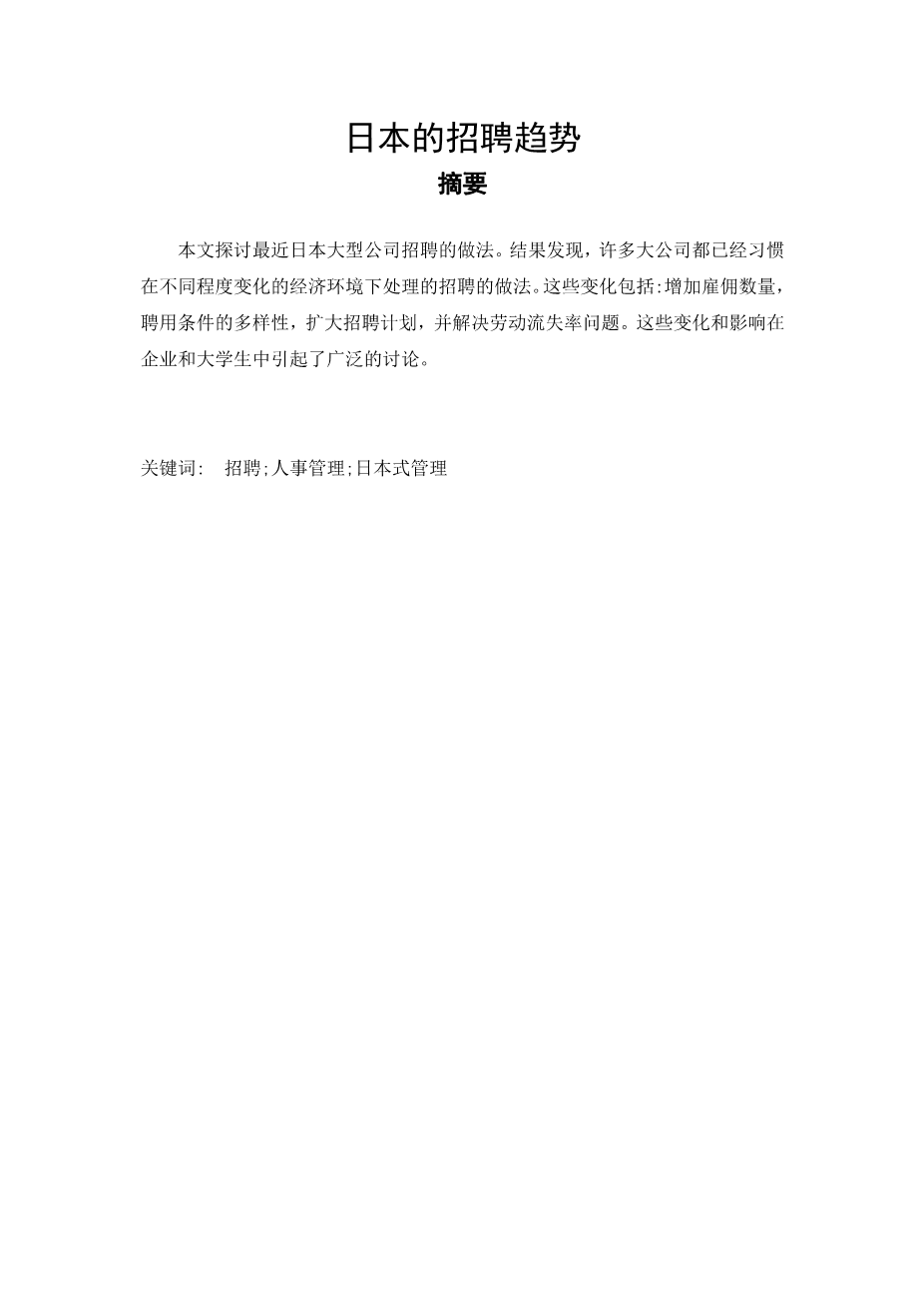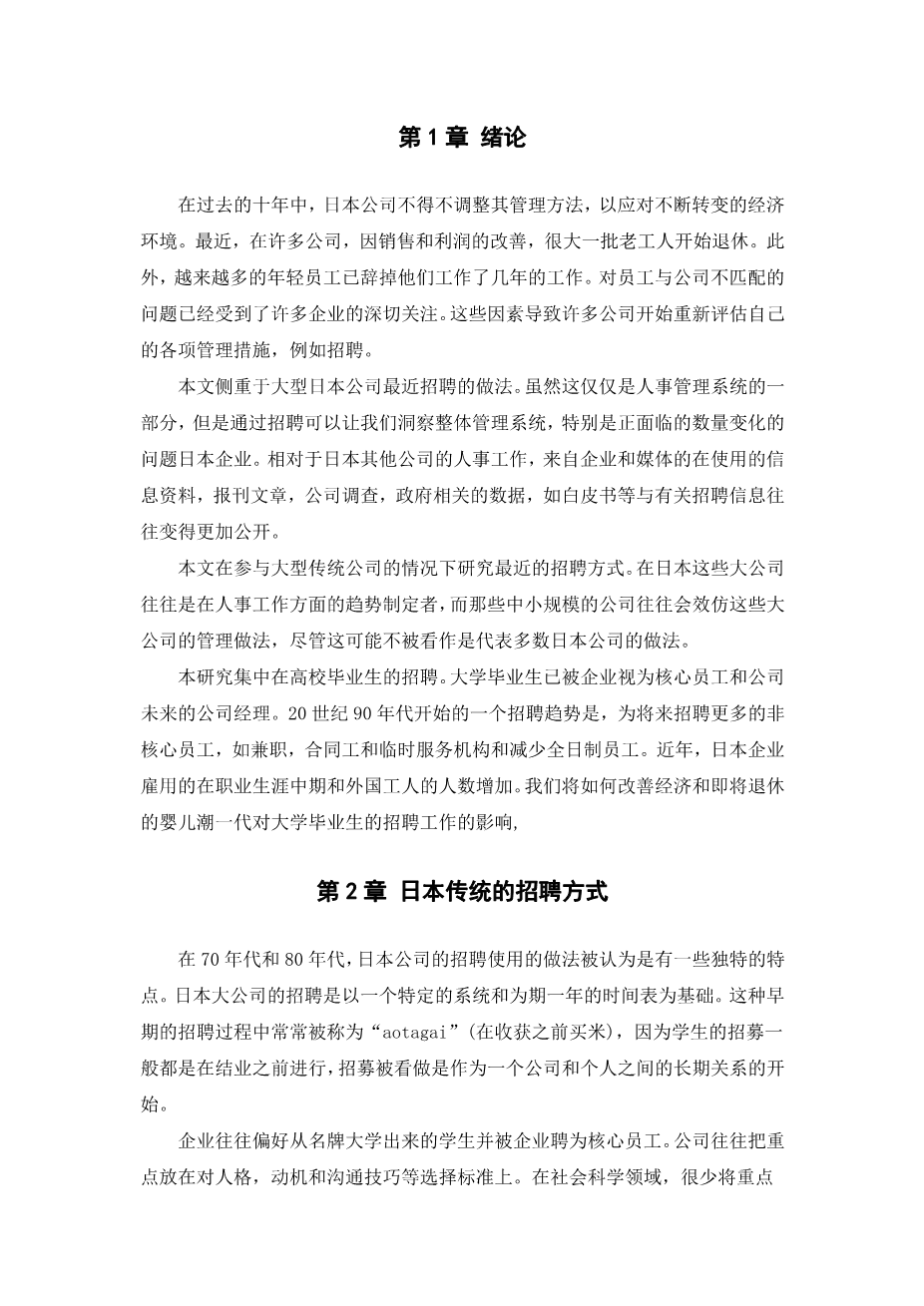Recruitment Trends in Japan
Abstract
This paper examines recent recruitment practices in large Japanese companies. It was found that many large companies have adapted recruitment practices in varying degrees to deal with the changing economic environment. These changes include increasing the number of hires, diversifying hiring conditions, extending the recruitment schedule, and dealing with labor turnover issues. The implications of these changes and the impact on companies and university students are then discussed.
Keywords: Recruitment, Personnel Management, Japanese-Style Management
Introduction
Over the past decade, Japanese companies had to adapt their management practices to deal with the changing economic environment. Recently, in many companies, a large number of older workers were starting to retire just as sales and profits were improving. Also, an increasing number of young employees have been quitting their jobs within a few years of being hired. The issue of employee-company mismatch has become a serious concern for many companies. These factors have led many companies to reassess their various management practices such as recruitment.
This paper focused on recent recruitment practices in large Japanese companies. Although it is only one part of the personnel management system, recruitment provides insight into understanding the overall management system, and in particular, issues Japanese companies are facing and the amount of change taking place. Compared with other personnel practices in Japanese companies, information relating to recruitment tends to be more openly available from companies and in the media. Information was obtained using company data, newspaper articles, company surveys, and government related data such as white papers.
This paper examined recent recruitment practices taking place in large traditional companies. These large companies tend to be the trend setters in terms of personnel practices in Japan. Small and medium-size companies in Japan tend to emulate theselarge company management practices. Practices in foreign companies and newer information technology companies although informative may not be as representative of the majority of Japanese company practices.
This research concentrated on the recruitment of university graduates. University graduates have been regarded as the core company employees and future company managers. One trend beginning in the 1990s was the hiring of more non-core employees such as part time, contract and workers from temp service agencies and reducing the number of full-time employees. in recent years, there has also been an increase in the number of mid-career and foreign workers being hired by Japanese companies.
Traditional Japanese Recruitment Practices
The recruitment practices used in Japanese companies in the 1970s and 1980s was viewed as having some unique characteristics. Recruitment in large Japanese companies was systematic and based on a specific year long schedule. This early recruitment process is often referred to as 'aotagai' (buying rice before it is harvested since students were recruited far in advance of graduation. Recruitment was seen as the beginning of a long-term relationship between the company and individual.
University graduates were hired as core employees. Preference was given by companies to students from prestigious universities. Companies tended to place emphasis on personality,motivation and communication skills as selection criteria. in the social science area,little emphasis was placed on what was studied in university or on the specific skills or experiences of the candidate.in the natural sciences, in particular, students were often recommended to companies by their professors.
The recruitment season usually began in April when a student entered fourth year. The applicant would have to pass a number of written tests and interviews. The interviews were regarded as the most important part of the selection process. During this process, students were given little input with regard To their future job or work location.
After this process was completed, an advance agreement of employment was reached with the applicants. This advance agreement of employment with applicants is still used by companies today. These students would then all start together the following year in April. Recruits would join a company without knowing which position or department they would be joining.
During the 1990s, the Japanese economy went into a prolonged recession and this impacted the recruitment practices in many companies. To deal with the recession, companies were forced to cut labor costs. One way this was done was to hire more part-time workers and reduce the number of full-time employees. This was a big change from recruitment practices in the 1980s when companies actively increased the number of full-time employees.
Recent Recruitment Trends
3.1 Companies Increase Hiring
Over the last five years the overall economy has been recovering and many companies have seen their sales and profits rise. As well, companies have been concerned about the increasing number of retirees. Japanese baby boomers have started to retire in 2007. Companies have been looking for replacements for these employees and also planning for the future. These factors have led companies to increase the number of recruits from universities in 2007. These numbers were similar to the number of new recruits hired in 1990 at the peak of the Economic Bubble.Recruitment had become a sellerrsquo;s market.
Many large companies have been increasing the number of recruits for four consecutive years. In 2007, around 44 percent of the companys surveyed indicated they were going to hire more than the previous year. 47 percent of the companies stated that they would be hiring about the same number as last year. Of
剩余内容已隐藏,支付完成后下载完整资料


英语译文共 8 页,剩余内容已隐藏,支付完成后下载完整资料
资料编号:[607458],资料为PDF文档或Word文档,PDF文档可免费转换为Word
您可能感兴趣的文章
- 饮用水微生物群:一个全面的时空研究,以监测巴黎供水系统的水质外文翻译资料
- 步进电机控制和摩擦模型对复杂机械系统精确定位的影响外文翻译资料
- 具有温湿度控制的开式阴极PEM燃料电池性能的提升外文翻译资料
- 警报定时系统对驾驶员行为的影响:调查驾驶员信任的差异以及根据警报定时对警报的响应外文翻译资料
- 门禁系统的零知识认证解决方案外文翻译资料
- 车辆废气及室外环境中悬浮微粒中有机磷的含量—-个案研究外文翻译资料
- ZigBee协议对城市风力涡轮机的无线监控: 支持应用软件和传感器模块外文翻译资料
- ZigBee系统在医疗保健中提供位置信息和传感器数据传输的方案外文翻译资料
- 基于PLC的模糊控制器在污水处理系统中的应用外文翻译资料
- 光伏并联最大功率点跟踪系统独立应用程序外文翻译资料



